Investigating Green Concrete in Construction Industry
VerifiedAdded on 2023/03/21
|10
|3868
|67
Report
AI Summary
This report investigates the utilization of green concrete in the construction industry as a step towards sustainable development. It reviews existing literature on various types of green concrete, including ultra-high-performance concrete, lightweight concrete, geopolymer concrete, and fly ash concrete...

STUDENT NAME - - Assignment 2
07 September 2016 1
07 September 2016 1
Paraphrase This Document
Need a fresh take? Get an instant paraphrase of this document with our AI Paraphraser
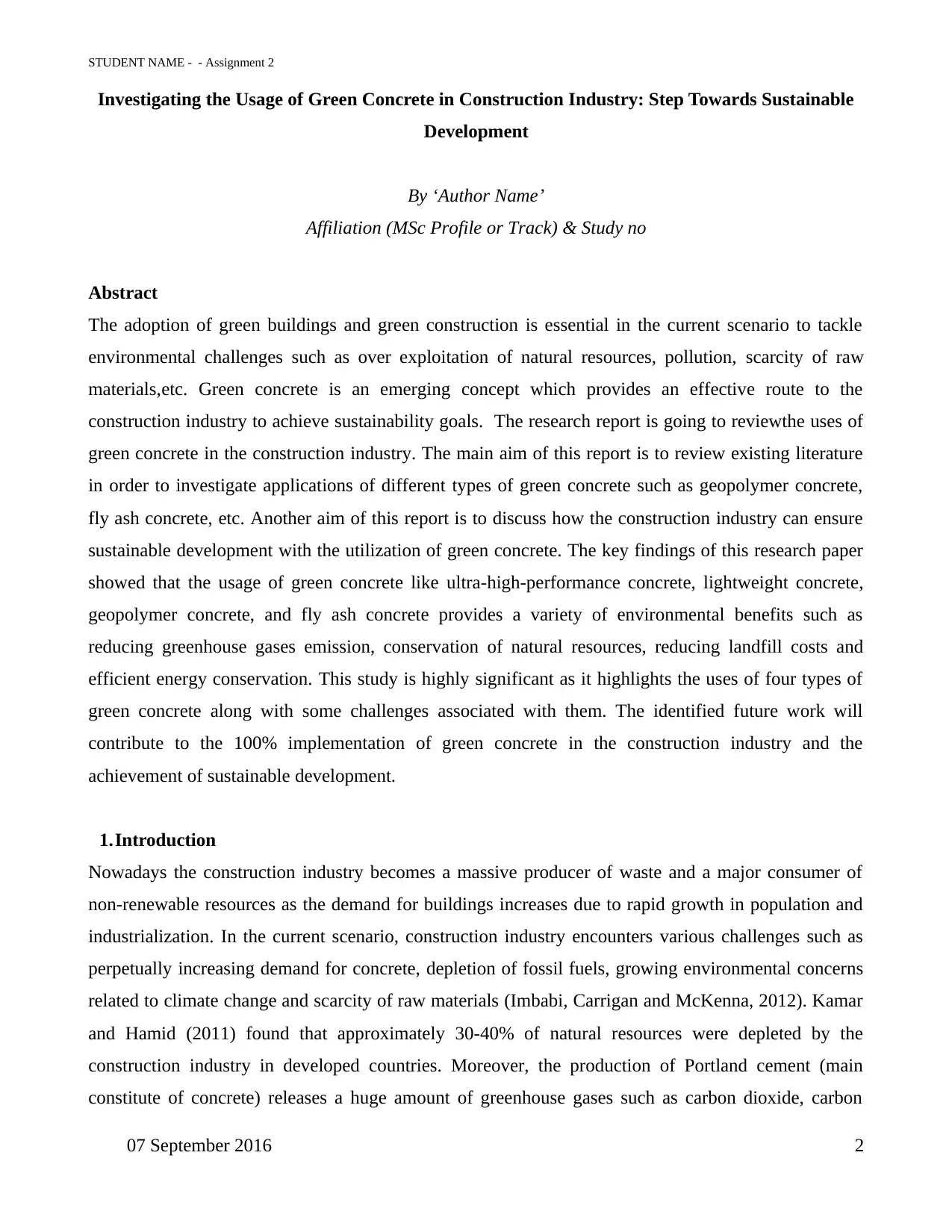
STUDENT NAME - - Assignment 2
Investigating the Usage of Green Concrete in Construction Industry: Step Towards Sustainable
Development
By ‘Author Name’
Affiliation (MSc Profile or Track) & Study no
Abstract
The adoption of green buildings and green construction is essential in the current scenario to tackle
environmental challenges such as over exploitation of natural resources, pollution, scarcity of raw
materials,etc. Green concrete is an emerging concept which provides an effective route to the
construction industry to achieve sustainability goals. The research report is going to reviewthe uses of
green concrete in the construction industry. The main aim of this report is to review existing literature
in order to investigate applications of different types of green concrete such as geopolymer concrete,
fly ash concrete, etc. Another aim of this report is to discuss how the construction industry can ensure
sustainable development with the utilization of green concrete. The key findings of this research paper
showed that the usage of green concrete like ultra-high-performance concrete, lightweight concrete,
geopolymer concrete, and fly ash concrete provides a variety of environmental benefits such as
reducing greenhouse gases emission, conservation of natural resources, reducing landfill costs and
efficient energy conservation. This study is highly significant as it highlights the uses of four types of
green concrete along with some challenges associated with them. The identified future work will
contribute to the 100% implementation of green concrete in the construction industry and the
achievement of sustainable development.
1.Introduction
Nowadays the construction industry becomes a massive producer of waste and a major consumer of
non-renewable resources as the demand for buildings increases due to rapid growth in population and
industrialization. In the current scenario, construction industry encounters various challenges such as
perpetually increasing demand for concrete, depletion of fossil fuels, growing environmental concerns
related to climate change and scarcity of raw materials (Imbabi, Carrigan and McKenna, 2012). Kamar
and Hamid (2011) found that approximately 30-40% of natural resources were depleted by the
construction industry in developed countries. Moreover, the production of Portland cement (main
constitute of concrete) releases a huge amount of greenhouse gases such as carbon dioxide, carbon
07 September 2016 2
Investigating the Usage of Green Concrete in Construction Industry: Step Towards Sustainable
Development
By ‘Author Name’
Affiliation (MSc Profile or Track) & Study no
Abstract
The adoption of green buildings and green construction is essential in the current scenario to tackle
environmental challenges such as over exploitation of natural resources, pollution, scarcity of raw
materials,etc. Green concrete is an emerging concept which provides an effective route to the
construction industry to achieve sustainability goals. The research report is going to reviewthe uses of
green concrete in the construction industry. The main aim of this report is to review existing literature
in order to investigate applications of different types of green concrete such as geopolymer concrete,
fly ash concrete, etc. Another aim of this report is to discuss how the construction industry can ensure
sustainable development with the utilization of green concrete. The key findings of this research paper
showed that the usage of green concrete like ultra-high-performance concrete, lightweight concrete,
geopolymer concrete, and fly ash concrete provides a variety of environmental benefits such as
reducing greenhouse gases emission, conservation of natural resources, reducing landfill costs and
efficient energy conservation. This study is highly significant as it highlights the uses of four types of
green concrete along with some challenges associated with them. The identified future work will
contribute to the 100% implementation of green concrete in the construction industry and the
achievement of sustainable development.
1.Introduction
Nowadays the construction industry becomes a massive producer of waste and a major consumer of
non-renewable resources as the demand for buildings increases due to rapid growth in population and
industrialization. In the current scenario, construction industry encounters various challenges such as
perpetually increasing demand for concrete, depletion of fossil fuels, growing environmental concerns
related to climate change and scarcity of raw materials (Imbabi, Carrigan and McKenna, 2012). Kamar
and Hamid (2011) found that approximately 30-40% of natural resources were depleted by the
construction industry in developed countries. Moreover, the production of Portland cement (main
constitute of concrete) releases a huge amount of greenhouse gases such as carbon dioxide, carbon
07 September 2016 2
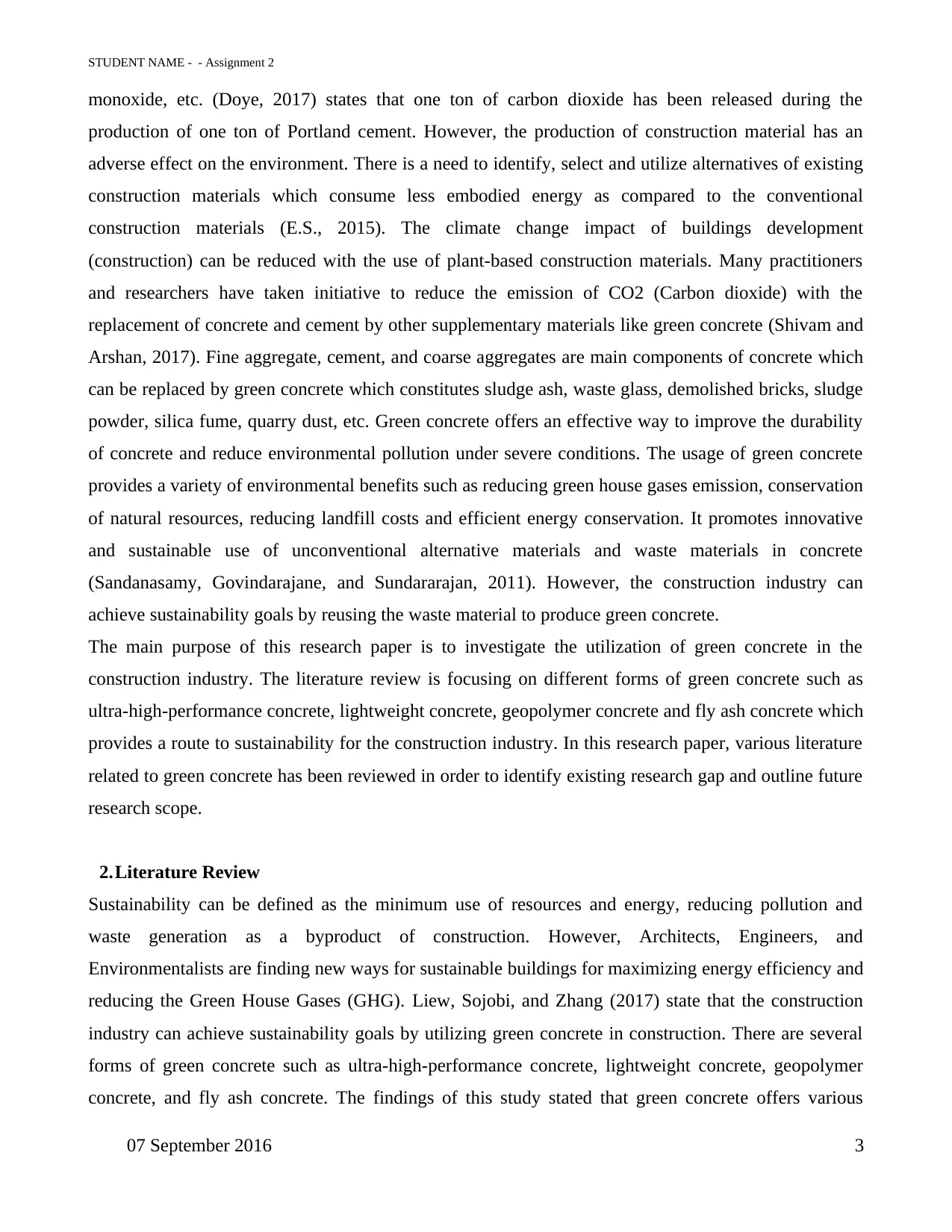
STUDENT NAME - - Assignment 2
monoxide, etc. (Doye, 2017) states that one ton of carbon dioxide has been released during the
production of one ton of Portland cement. However, the production of construction material has an
adverse effect on the environment. There is a need to identify, select and utilize alternatives of existing
construction materials which consume less embodied energy as compared to the conventional
construction materials (E.S., 2015). The climate change impact of buildings development
(construction) can be reduced with the use of plant-based construction materials. Many practitioners
and researchers have taken initiative to reduce the emission of CO2 (Carbon dioxide) with the
replacement of concrete and cement by other supplementary materials like green concrete (Shivam and
Arshan, 2017). Fine aggregate, cement, and coarse aggregates are main components of concrete which
can be replaced by green concrete which constitutes sludge ash, waste glass, demolished bricks, sludge
powder, silica fume, quarry dust, etc. Green concrete offers an effective way to improve the durability
of concrete and reduce environmental pollution under severe conditions. The usage of green concrete
provides a variety of environmental benefits such as reducing green house gases emission, conservation
of natural resources, reducing landfill costs and efficient energy conservation. It promotes innovative
and sustainable use of unconventional alternative materials and waste materials in concrete
(Sandanasamy, Govindarajane, and Sundararajan, 2011). However, the construction industry can
achieve sustainability goals by reusing the waste material to produce green concrete.
The main purpose of this research paper is to investigate the utilization of green concrete in the
construction industry. The literature review is focusing on different forms of green concrete such as
ultra-high-performance concrete, lightweight concrete, geopolymer concrete and fly ash concrete which
provides a route to sustainability for the construction industry. In this research paper, various literature
related to green concrete has been reviewed in order to identify existing research gap and outline future
research scope.
2.Literature Review
Sustainability can be defined as the minimum use of resources and energy, reducing pollution and
waste generation as a byproduct of construction. However, Architects, Engineers, and
Environmentalists are finding new ways for sustainable buildings for maximizing energy efficiency and
reducing the Green House Gases (GHG). Liew, Sojobi, and Zhang (2017) state that the construction
industry can achieve sustainability goals by utilizing green concrete in construction. There are several
forms of green concrete such as ultra-high-performance concrete, lightweight concrete, geopolymer
concrete, and fly ash concrete. The findings of this study stated that green concrete offers various
07 September 2016 3
monoxide, etc. (Doye, 2017) states that one ton of carbon dioxide has been released during the
production of one ton of Portland cement. However, the production of construction material has an
adverse effect on the environment. There is a need to identify, select and utilize alternatives of existing
construction materials which consume less embodied energy as compared to the conventional
construction materials (E.S., 2015). The climate change impact of buildings development
(construction) can be reduced with the use of plant-based construction materials. Many practitioners
and researchers have taken initiative to reduce the emission of CO2 (Carbon dioxide) with the
replacement of concrete and cement by other supplementary materials like green concrete (Shivam and
Arshan, 2017). Fine aggregate, cement, and coarse aggregates are main components of concrete which
can be replaced by green concrete which constitutes sludge ash, waste glass, demolished bricks, sludge
powder, silica fume, quarry dust, etc. Green concrete offers an effective way to improve the durability
of concrete and reduce environmental pollution under severe conditions. The usage of green concrete
provides a variety of environmental benefits such as reducing green house gases emission, conservation
of natural resources, reducing landfill costs and efficient energy conservation. It promotes innovative
and sustainable use of unconventional alternative materials and waste materials in concrete
(Sandanasamy, Govindarajane, and Sundararajan, 2011). However, the construction industry can
achieve sustainability goals by reusing the waste material to produce green concrete.
The main purpose of this research paper is to investigate the utilization of green concrete in the
construction industry. The literature review is focusing on different forms of green concrete such as
ultra-high-performance concrete, lightweight concrete, geopolymer concrete and fly ash concrete which
provides a route to sustainability for the construction industry. In this research paper, various literature
related to green concrete has been reviewed in order to identify existing research gap and outline future
research scope.
2.Literature Review
Sustainability can be defined as the minimum use of resources and energy, reducing pollution and
waste generation as a byproduct of construction. However, Architects, Engineers, and
Environmentalists are finding new ways for sustainable buildings for maximizing energy efficiency and
reducing the Green House Gases (GHG). Liew, Sojobi, and Zhang (2017) state that the construction
industry can achieve sustainability goals by utilizing green concrete in construction. There are several
forms of green concrete such as ultra-high-performance concrete, lightweight concrete, geopolymer
concrete, and fly ash concrete. The findings of this study stated that green concrete offers various
07 September 2016 3
You're viewing a preview
Unlock full access by subscribing today!
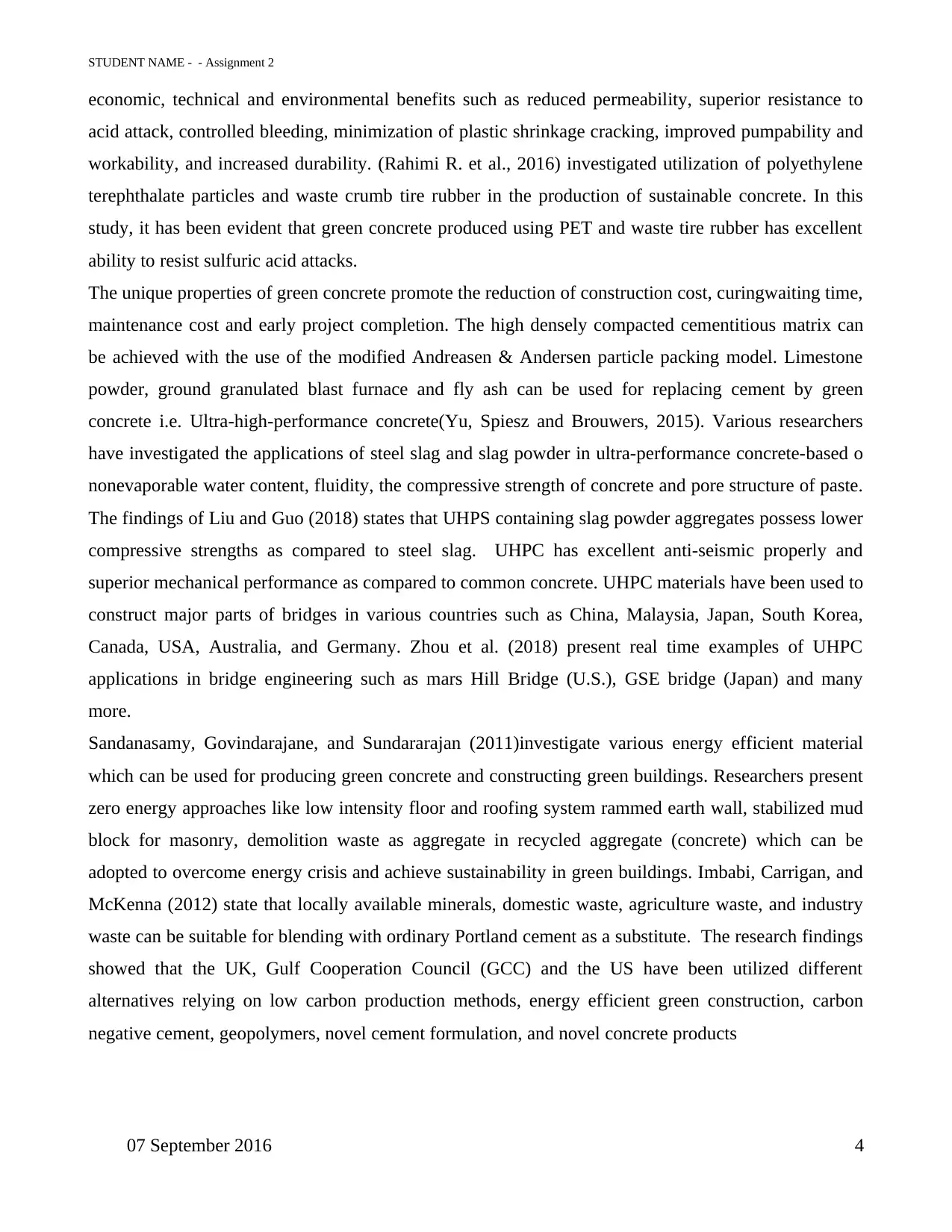
STUDENT NAME - - Assignment 2
economic, technical and environmental benefits such as reduced permeability, superior resistance to
acid attack, controlled bleeding, minimization of plastic shrinkage cracking, improved pumpability and
workability, and increased durability. (Rahimi R. et al., 2016) investigated utilization of polyethylene
terephthalate particles and waste crumb tire rubber in the production of sustainable concrete. In this
study, it has been evident that green concrete produced using PET and waste tire rubber has excellent
ability to resist sulfuric acid attacks.
The unique properties of green concrete promote the reduction of construction cost, curingwaiting time,
maintenance cost and early project completion. The high densely compacted cementitious matrix can
be achieved with the use of the modified Andreasen & Andersen particle packing model. Limestone
powder, ground granulated blast furnace and fly ash can be used for replacing cement by green
concrete i.e. Ultra-high-performance concrete(Yu, Spiesz and Brouwers, 2015). Various researchers
have investigated the applications of steel slag and slag powder in ultra-performance concrete-based o
nonevaporable water content, fluidity, the compressive strength of concrete and pore structure of paste.
The findings of Liu and Guo (2018) states that UHPS containing slag powder aggregates possess lower
compressive strengths as compared to steel slag. UHPC has excellent anti-seismic properly and
superior mechanical performance as compared to common concrete. UHPC materials have been used to
construct major parts of bridges in various countries such as China, Malaysia, Japan, South Korea,
Canada, USA, Australia, and Germany. Zhou et al. (2018) present real time examples of UHPC
applications in bridge engineering such as mars Hill Bridge (U.S.), GSE bridge (Japan) and many
more.
Sandanasamy, Govindarajane, and Sundararajan (2011)investigate various energy efficient material
which can be used for producing green concrete and constructing green buildings. Researchers present
zero energy approaches like low intensity floor and roofing system rammed earth wall, stabilized mud
block for masonry, demolition waste as aggregate in recycled aggregate (concrete) which can be
adopted to overcome energy crisis and achieve sustainability in green buildings. Imbabi, Carrigan, and
McKenna (2012) state that locally available minerals, domestic waste, agriculture waste, and industry
waste can be suitable for blending with ordinary Portland cement as a substitute. The research findings
showed that the UK, Gulf Cooperation Council (GCC) and the US have been utilized different
alternatives relying on low carbon production methods, energy efficient green construction, carbon
negative cement, geopolymers, novel cement formulation, and novel concrete products
07 September 2016 4
economic, technical and environmental benefits such as reduced permeability, superior resistance to
acid attack, controlled bleeding, minimization of plastic shrinkage cracking, improved pumpability and
workability, and increased durability. (Rahimi R. et al., 2016) investigated utilization of polyethylene
terephthalate particles and waste crumb tire rubber in the production of sustainable concrete. In this
study, it has been evident that green concrete produced using PET and waste tire rubber has excellent
ability to resist sulfuric acid attacks.
The unique properties of green concrete promote the reduction of construction cost, curingwaiting time,
maintenance cost and early project completion. The high densely compacted cementitious matrix can
be achieved with the use of the modified Andreasen & Andersen particle packing model. Limestone
powder, ground granulated blast furnace and fly ash can be used for replacing cement by green
concrete i.e. Ultra-high-performance concrete(Yu, Spiesz and Brouwers, 2015). Various researchers
have investigated the applications of steel slag and slag powder in ultra-performance concrete-based o
nonevaporable water content, fluidity, the compressive strength of concrete and pore structure of paste.
The findings of Liu and Guo (2018) states that UHPS containing slag powder aggregates possess lower
compressive strengths as compared to steel slag. UHPC has excellent anti-seismic properly and
superior mechanical performance as compared to common concrete. UHPC materials have been used to
construct major parts of bridges in various countries such as China, Malaysia, Japan, South Korea,
Canada, USA, Australia, and Germany. Zhou et al. (2018) present real time examples of UHPC
applications in bridge engineering such as mars Hill Bridge (U.S.), GSE bridge (Japan) and many
more.
Sandanasamy, Govindarajane, and Sundararajan (2011)investigate various energy efficient material
which can be used for producing green concrete and constructing green buildings. Researchers present
zero energy approaches like low intensity floor and roofing system rammed earth wall, stabilized mud
block for masonry, demolition waste as aggregate in recycled aggregate (concrete) which can be
adopted to overcome energy crisis and achieve sustainability in green buildings. Imbabi, Carrigan, and
McKenna (2012) state that locally available minerals, domestic waste, agriculture waste, and industry
waste can be suitable for blending with ordinary Portland cement as a substitute. The research findings
showed that the UK, Gulf Cooperation Council (GCC) and the US have been utilized different
alternatives relying on low carbon production methods, energy efficient green construction, carbon
negative cement, geopolymers, novel cement formulation, and novel concrete products
07 September 2016 4
Paraphrase This Document
Need a fresh take? Get an instant paraphrase of this document with our AI Paraphraser

STUDENT NAME - - Assignment 2
Chen, Wang, and Jhou (2013) replaced the aggregates and cement used in the production of lightweight
cement with green building material (like waste tire rubber plastic, waste LCD glass sand particles,
etc.). In this study, it has been evident that good workability of concrete can be maintained effectively
by adding recycled green building material. When the replacement value is seventy percent, then the
weight of concrete can be reduced by 1.4 times. Hamad (2014) systematically reviews applications,
materials, properties, and production of aerated lightweight concrete. The research findings included
that utilization of lightweight concrete offers many advantages to the construction industry as it has a
higher strength to weight ratio, lower coefficient of thermal expansion and better tensile strain capacity.
Aerated concrete blocks have been utilized for roof insulation, pipeline backfilling, road widening,
culvert, and bridge backfill, resolving to bump at bridge head.
Fly ash-rich in aluminum and silica, sodium silicate (or potassium silicate) and sodium hydroxide are
main constitutes of geopolymer concrete (Aleem and Arumairaj, 2012). Geopolymer concrete has been
produced by combining the waste water from chemical refineries and fly ash from the thermal industry.
However, it reduces environmental pollution caused by the emission of carbon dioxide during the
production of ordinary Portland cement concrete. It has been widely used for constructing bridges,
structural retrofits, structural elements, and decks. Moreover, it can also be used in rehabilitation and
repair work. There are some technical hurdles associated with geopolymer concrete such as practical
difficulties in applying high temperature curing process, high cost for an alkaline solution, etc. that
need to be resolved (Aleem and Arumairaj, 2012). Ang and Lu (2018) analyzed the impact of fly ash
replacement in terms of corrosion rate and electrical resistivity of concrete. The research findings
indicated that the corrosion rate decreases with the increase in fly ash replacement whereas concrete
resistivity increases with increase in fly ash replacement. Mathew and Sudhakar (2013) investigate the
strength, sustainability and economic characteristics of coal ash in context to geopolymer concrete. The
research findings show that geopolymer concrete can be produced in cost effective way by using
industry waste such as Ground granulate blast furnace and fly ash (Mohajerani et al., 2019). It has been
observed that the embodied energy of OPC based concrete is 2083.33 MJ which is very high as
compared to fly ash GGBS based geopolymer concrete i.e. 1265.73 MJ. However, the construction
industry can use Fly-ash and GGBS based geopolymer concrete as a sustainable construction material.
This study does not provide information about the critical barriers which could affect the adoption of
green concrete.
07 September 2016 5
Chen, Wang, and Jhou (2013) replaced the aggregates and cement used in the production of lightweight
cement with green building material (like waste tire rubber plastic, waste LCD glass sand particles,
etc.). In this study, it has been evident that good workability of concrete can be maintained effectively
by adding recycled green building material. When the replacement value is seventy percent, then the
weight of concrete can be reduced by 1.4 times. Hamad (2014) systematically reviews applications,
materials, properties, and production of aerated lightweight concrete. The research findings included
that utilization of lightweight concrete offers many advantages to the construction industry as it has a
higher strength to weight ratio, lower coefficient of thermal expansion and better tensile strain capacity.
Aerated concrete blocks have been utilized for roof insulation, pipeline backfilling, road widening,
culvert, and bridge backfill, resolving to bump at bridge head.
Fly ash-rich in aluminum and silica, sodium silicate (or potassium silicate) and sodium hydroxide are
main constitutes of geopolymer concrete (Aleem and Arumairaj, 2012). Geopolymer concrete has been
produced by combining the waste water from chemical refineries and fly ash from the thermal industry.
However, it reduces environmental pollution caused by the emission of carbon dioxide during the
production of ordinary Portland cement concrete. It has been widely used for constructing bridges,
structural retrofits, structural elements, and decks. Moreover, it can also be used in rehabilitation and
repair work. There are some technical hurdles associated with geopolymer concrete such as practical
difficulties in applying high temperature curing process, high cost for an alkaline solution, etc. that
need to be resolved (Aleem and Arumairaj, 2012). Ang and Lu (2018) analyzed the impact of fly ash
replacement in terms of corrosion rate and electrical resistivity of concrete. The research findings
indicated that the corrosion rate decreases with the increase in fly ash replacement whereas concrete
resistivity increases with increase in fly ash replacement. Mathew and Sudhakar (2013) investigate the
strength, sustainability and economic characteristics of coal ash in context to geopolymer concrete. The
research findings show that geopolymer concrete can be produced in cost effective way by using
industry waste such as Ground granulate blast furnace and fly ash (Mohajerani et al., 2019). It has been
observed that the embodied energy of OPC based concrete is 2083.33 MJ which is very high as
compared to fly ash GGBS based geopolymer concrete i.e. 1265.73 MJ. However, the construction
industry can use Fly-ash and GGBS based geopolymer concrete as a sustainable construction material.
This study does not provide information about the critical barriers which could affect the adoption of
green concrete.
07 September 2016 5
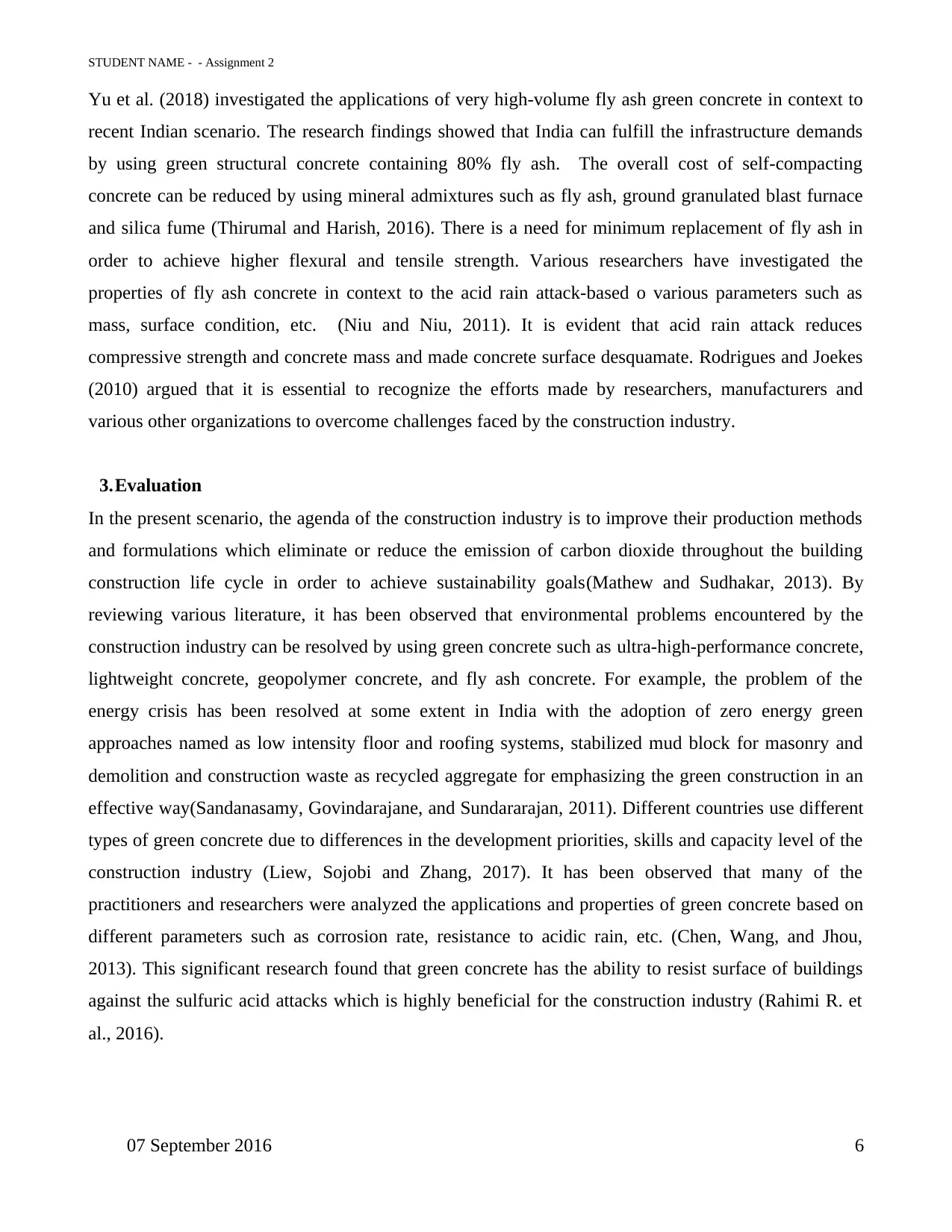
STUDENT NAME - - Assignment 2
Yu et al. (2018) investigated the applications of very high-volume fly ash green concrete in context to
recent Indian scenario. The research findings showed that India can fulfill the infrastructure demands
by using green structural concrete containing 80% fly ash. The overall cost of self-compacting
concrete can be reduced by using mineral admixtures such as fly ash, ground granulated blast furnace
and silica fume (Thirumal and Harish, 2016). There is a need for minimum replacement of fly ash in
order to achieve higher flexural and tensile strength. Various researchers have investigated the
properties of fly ash concrete in context to the acid rain attack-based o various parameters such as
mass, surface condition, etc. (Niu and Niu, 2011). It is evident that acid rain attack reduces
compressive strength and concrete mass and made concrete surface desquamate. Rodrigues and Joekes
(2010) argued that it is essential to recognize the efforts made by researchers, manufacturers and
various other organizations to overcome challenges faced by the construction industry.
3.Evaluation
In the present scenario, the agenda of the construction industry is to improve their production methods
and formulations which eliminate or reduce the emission of carbon dioxide throughout the building
construction life cycle in order to achieve sustainability goals(Mathew and Sudhakar, 2013). By
reviewing various literature, it has been observed that environmental problems encountered by the
construction industry can be resolved by using green concrete such as ultra-high-performance concrete,
lightweight concrete, geopolymer concrete, and fly ash concrete. For example, the problem of the
energy crisis has been resolved at some extent in India with the adoption of zero energy green
approaches named as low intensity floor and roofing systems, stabilized mud block for masonry and
demolition and construction waste as recycled aggregate for emphasizing the green construction in an
effective way(Sandanasamy, Govindarajane, and Sundararajan, 2011). Different countries use different
types of green concrete due to differences in the development priorities, skills and capacity level of the
construction industry (Liew, Sojobi and Zhang, 2017). It has been observed that many of the
practitioners and researchers were analyzed the applications and properties of green concrete based on
different parameters such as corrosion rate, resistance to acidic rain, etc. (Chen, Wang, and Jhou,
2013). This significant research found that green concrete has the ability to resist surface of buildings
against the sulfuric acid attacks which is highly beneficial for the construction industry (Rahimi R. et
al., 2016).
07 September 2016 6
Yu et al. (2018) investigated the applications of very high-volume fly ash green concrete in context to
recent Indian scenario. The research findings showed that India can fulfill the infrastructure demands
by using green structural concrete containing 80% fly ash. The overall cost of self-compacting
concrete can be reduced by using mineral admixtures such as fly ash, ground granulated blast furnace
and silica fume (Thirumal and Harish, 2016). There is a need for minimum replacement of fly ash in
order to achieve higher flexural and tensile strength. Various researchers have investigated the
properties of fly ash concrete in context to the acid rain attack-based o various parameters such as
mass, surface condition, etc. (Niu and Niu, 2011). It is evident that acid rain attack reduces
compressive strength and concrete mass and made concrete surface desquamate. Rodrigues and Joekes
(2010) argued that it is essential to recognize the efforts made by researchers, manufacturers and
various other organizations to overcome challenges faced by the construction industry.
3.Evaluation
In the present scenario, the agenda of the construction industry is to improve their production methods
and formulations which eliminate or reduce the emission of carbon dioxide throughout the building
construction life cycle in order to achieve sustainability goals(Mathew and Sudhakar, 2013). By
reviewing various literature, it has been observed that environmental problems encountered by the
construction industry can be resolved by using green concrete such as ultra-high-performance concrete,
lightweight concrete, geopolymer concrete, and fly ash concrete. For example, the problem of the
energy crisis has been resolved at some extent in India with the adoption of zero energy green
approaches named as low intensity floor and roofing systems, stabilized mud block for masonry and
demolition and construction waste as recycled aggregate for emphasizing the green construction in an
effective way(Sandanasamy, Govindarajane, and Sundararajan, 2011). Different countries use different
types of green concrete due to differences in the development priorities, skills and capacity level of the
construction industry (Liew, Sojobi and Zhang, 2017). It has been observed that many of the
practitioners and researchers were analyzed the applications and properties of green concrete based on
different parameters such as corrosion rate, resistance to acidic rain, etc. (Chen, Wang, and Jhou,
2013). This significant research found that green concrete has the ability to resist surface of buildings
against the sulfuric acid attacks which is highly beneficial for the construction industry (Rahimi R. et
al., 2016).
07 September 2016 6
You're viewing a preview
Unlock full access by subscribing today!
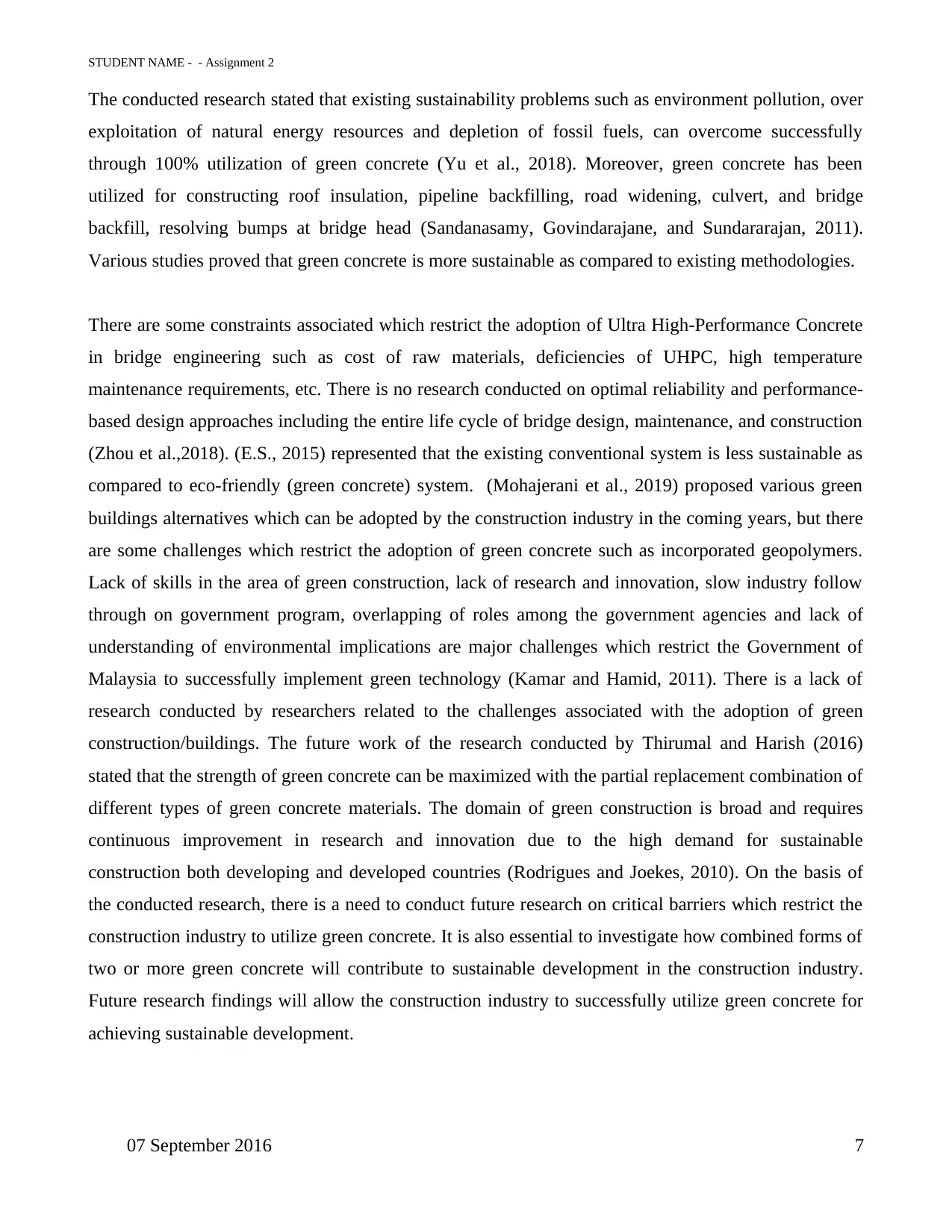
STUDENT NAME - - Assignment 2
The conducted research stated that existing sustainability problems such as environment pollution, over
exploitation of natural energy resources and depletion of fossil fuels, can overcome successfully
through 100% utilization of green concrete (Yu et al., 2018). Moreover, green concrete has been
utilized for constructing roof insulation, pipeline backfilling, road widening, culvert, and bridge
backfill, resolving bumps at bridge head (Sandanasamy, Govindarajane, and Sundararajan, 2011).
Various studies proved that green concrete is more sustainable as compared to existing methodologies.
There are some constraints associated which restrict the adoption of Ultra High-Performance Concrete
in bridge engineering such as cost of raw materials, deficiencies of UHPC, high temperature
maintenance requirements, etc. There is no research conducted on optimal reliability and performance-
based design approaches including the entire life cycle of bridge design, maintenance, and construction
(Zhou et al.,2018). (E.S., 2015) represented that the existing conventional system is less sustainable as
compared to eco-friendly (green concrete) system. (Mohajerani et al., 2019) proposed various green
buildings alternatives which can be adopted by the construction industry in the coming years, but there
are some challenges which restrict the adoption of green concrete such as incorporated geopolymers.
Lack of skills in the area of green construction, lack of research and innovation, slow industry follow
through on government program, overlapping of roles among the government agencies and lack of
understanding of environmental implications are major challenges which restrict the Government of
Malaysia to successfully implement green technology (Kamar and Hamid, 2011). There is a lack of
research conducted by researchers related to the challenges associated with the adoption of green
construction/buildings. The future work of the research conducted by Thirumal and Harish (2016)
stated that the strength of green concrete can be maximized with the partial replacement combination of
different types of green concrete materials. The domain of green construction is broad and requires
continuous improvement in research and innovation due to the high demand for sustainable
construction both developing and developed countries (Rodrigues and Joekes, 2010). On the basis of
the conducted research, there is a need to conduct future research on critical barriers which restrict the
construction industry to utilize green concrete. It is also essential to investigate how combined forms of
two or more green concrete will contribute to sustainable development in the construction industry.
Future research findings will allow the construction industry to successfully utilize green concrete for
achieving sustainable development.
07 September 2016 7
The conducted research stated that existing sustainability problems such as environment pollution, over
exploitation of natural energy resources and depletion of fossil fuels, can overcome successfully
through 100% utilization of green concrete (Yu et al., 2018). Moreover, green concrete has been
utilized for constructing roof insulation, pipeline backfilling, road widening, culvert, and bridge
backfill, resolving bumps at bridge head (Sandanasamy, Govindarajane, and Sundararajan, 2011).
Various studies proved that green concrete is more sustainable as compared to existing methodologies.
There are some constraints associated which restrict the adoption of Ultra High-Performance Concrete
in bridge engineering such as cost of raw materials, deficiencies of UHPC, high temperature
maintenance requirements, etc. There is no research conducted on optimal reliability and performance-
based design approaches including the entire life cycle of bridge design, maintenance, and construction
(Zhou et al.,2018). (E.S., 2015) represented that the existing conventional system is less sustainable as
compared to eco-friendly (green concrete) system. (Mohajerani et al., 2019) proposed various green
buildings alternatives which can be adopted by the construction industry in the coming years, but there
are some challenges which restrict the adoption of green concrete such as incorporated geopolymers.
Lack of skills in the area of green construction, lack of research and innovation, slow industry follow
through on government program, overlapping of roles among the government agencies and lack of
understanding of environmental implications are major challenges which restrict the Government of
Malaysia to successfully implement green technology (Kamar and Hamid, 2011). There is a lack of
research conducted by researchers related to the challenges associated with the adoption of green
construction/buildings. The future work of the research conducted by Thirumal and Harish (2016)
stated that the strength of green concrete can be maximized with the partial replacement combination of
different types of green concrete materials. The domain of green construction is broad and requires
continuous improvement in research and innovation due to the high demand for sustainable
construction both developing and developed countries (Rodrigues and Joekes, 2010). On the basis of
the conducted research, there is a need to conduct future research on critical barriers which restrict the
construction industry to utilize green concrete. It is also essential to investigate how combined forms of
two or more green concrete will contribute to sustainable development in the construction industry.
Future research findings will allow the construction industry to successfully utilize green concrete for
achieving sustainable development.
07 September 2016 7
Paraphrase This Document
Need a fresh take? Get an instant paraphrase of this document with our AI Paraphraser
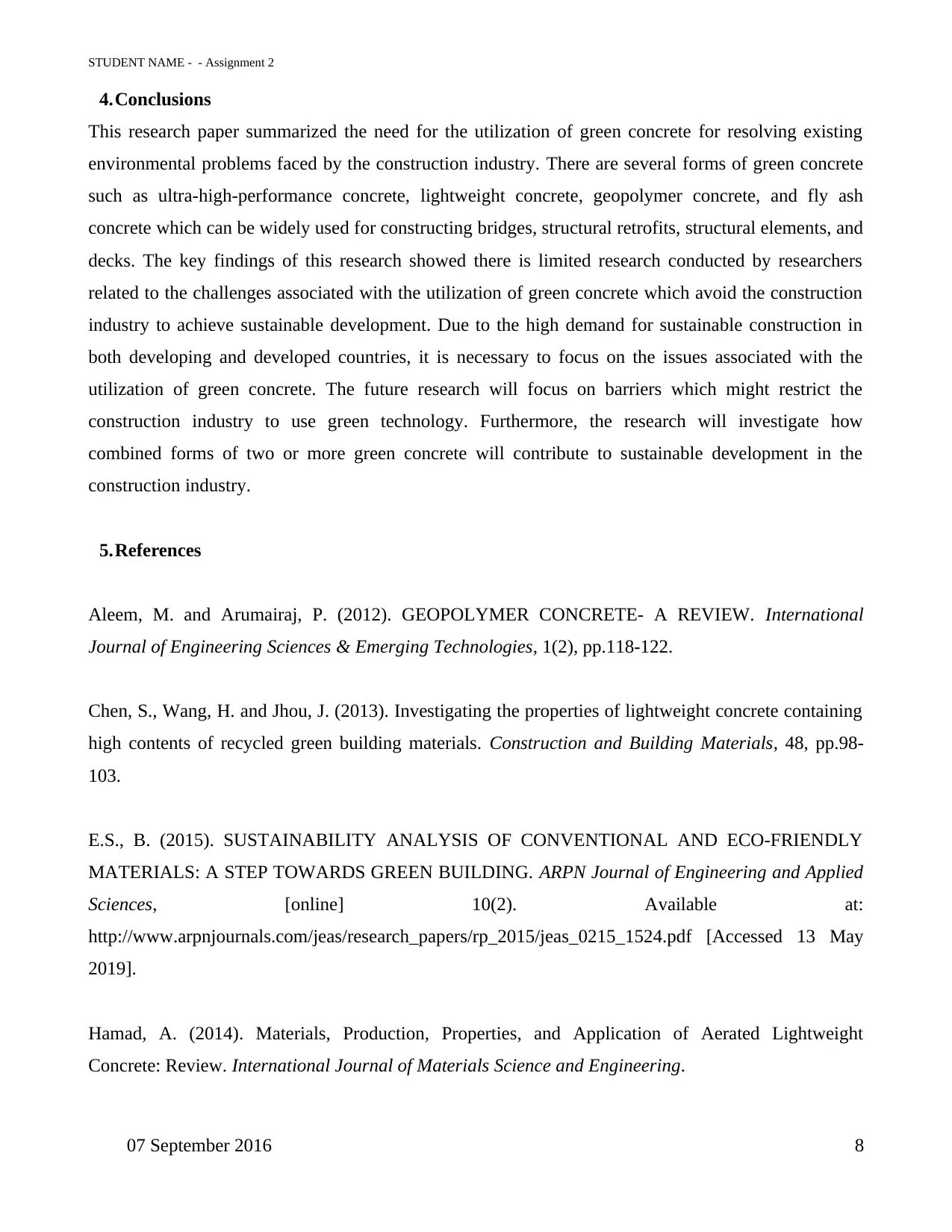
STUDENT NAME - - Assignment 2
4.Conclusions
This research paper summarized the need for the utilization of green concrete for resolving existing
environmental problems faced by the construction industry. There are several forms of green concrete
such as ultra-high-performance concrete, lightweight concrete, geopolymer concrete, and fly ash
concrete which can be widely used for constructing bridges, structural retrofits, structural elements, and
decks. The key findings of this research showed there is limited research conducted by researchers
related to the challenges associated with the utilization of green concrete which avoid the construction
industry to achieve sustainable development. Due to the high demand for sustainable construction in
both developing and developed countries, it is necessary to focus on the issues associated with the
utilization of green concrete. The future research will focus on barriers which might restrict the
construction industry to use green technology. Furthermore, the research will investigate how
combined forms of two or more green concrete will contribute to sustainable development in the
construction industry.
5.References
Aleem, M. and Arumairaj, P. (2012). GEOPOLYMER CONCRETE- A REVIEW. International
Journal of Engineering Sciences & Emerging Technologies, 1(2), pp.118-122.
Chen, S., Wang, H. and Jhou, J. (2013). Investigating the properties of lightweight concrete containing
high contents of recycled green building materials. Construction and Building Materials, 48, pp.98-
103.
E.S., B. (2015). SUSTAINABILITY ANALYSIS OF CONVENTIONAL AND ECO-FRIENDLY
MATERIALS: A STEP TOWARDS GREEN BUILDING. ARPN Journal of Engineering and Applied
Sciences, [online] 10(2). Available at:
http://www.arpnjournals.com/jeas/research_papers/rp_2015/jeas_0215_1524.pdf [Accessed 13 May
2019].
Hamad, A. (2014). Materials, Production, Properties, and Application of Aerated Lightweight
Concrete: Review. International Journal of Materials Science and Engineering.
07 September 2016 8
4.Conclusions
This research paper summarized the need for the utilization of green concrete for resolving existing
environmental problems faced by the construction industry. There are several forms of green concrete
such as ultra-high-performance concrete, lightweight concrete, geopolymer concrete, and fly ash
concrete which can be widely used for constructing bridges, structural retrofits, structural elements, and
decks. The key findings of this research showed there is limited research conducted by researchers
related to the challenges associated with the utilization of green concrete which avoid the construction
industry to achieve sustainable development. Due to the high demand for sustainable construction in
both developing and developed countries, it is necessary to focus on the issues associated with the
utilization of green concrete. The future research will focus on barriers which might restrict the
construction industry to use green technology. Furthermore, the research will investigate how
combined forms of two or more green concrete will contribute to sustainable development in the
construction industry.
5.References
Aleem, M. and Arumairaj, P. (2012). GEOPOLYMER CONCRETE- A REVIEW. International
Journal of Engineering Sciences & Emerging Technologies, 1(2), pp.118-122.
Chen, S., Wang, H. and Jhou, J. (2013). Investigating the properties of lightweight concrete containing
high contents of recycled green building materials. Construction and Building Materials, 48, pp.98-
103.
E.S., B. (2015). SUSTAINABILITY ANALYSIS OF CONVENTIONAL AND ECO-FRIENDLY
MATERIALS: A STEP TOWARDS GREEN BUILDING. ARPN Journal of Engineering and Applied
Sciences, [online] 10(2). Available at:
http://www.arpnjournals.com/jeas/research_papers/rp_2015/jeas_0215_1524.pdf [Accessed 13 May
2019].
Hamad, A. (2014). Materials, Production, Properties, and Application of Aerated Lightweight
Concrete: Review. International Journal of Materials Science and Engineering.
07 September 2016 8
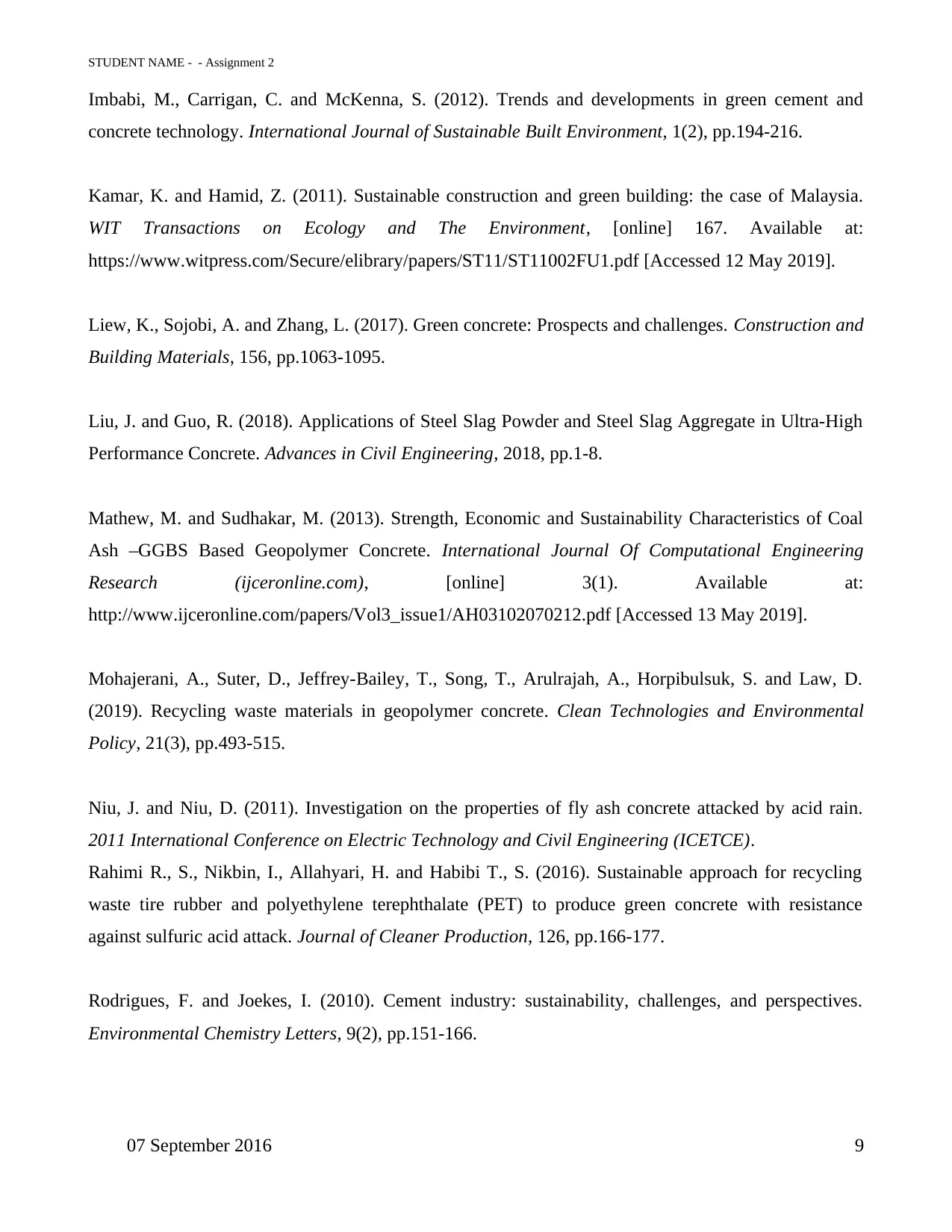
STUDENT NAME - - Assignment 2
Imbabi, M., Carrigan, C. and McKenna, S. (2012). Trends and developments in green cement and
concrete technology. International Journal of Sustainable Built Environment, 1(2), pp.194-216.
Kamar, K. and Hamid, Z. (2011). Sustainable construction and green building: the case of Malaysia.
WIT Transactions on Ecology and The Environment, [online] 167. Available at:
https://www.witpress.com/Secure/elibrary/papers/ST11/ST11002FU1.pdf [Accessed 12 May 2019].
Liew, K., Sojobi, A. and Zhang, L. (2017). Green concrete: Prospects and challenges. Construction and
Building Materials, 156, pp.1063-1095.
Liu, J. and Guo, R. (2018). Applications of Steel Slag Powder and Steel Slag Aggregate in Ultra-High
Performance Concrete. Advances in Civil Engineering, 2018, pp.1-8.
Mathew, M. and Sudhakar, M. (2013). Strength, Economic and Sustainability Characteristics of Coal
Ash –GGBS Based Geopolymer Concrete. International Journal Of Computational Engineering
Research (ijceronline.com), [online] 3(1). Available at:
http://www.ijceronline.com/papers/Vol3_issue1/AH03102070212.pdf [Accessed 13 May 2019].
Mohajerani, A., Suter, D., Jeffrey-Bailey, T., Song, T., Arulrajah, A., Horpibulsuk, S. and Law, D.
(2019). Recycling waste materials in geopolymer concrete. Clean Technologies and Environmental
Policy, 21(3), pp.493-515.
Niu, J. and Niu, D. (2011). Investigation on the properties of fly ash concrete attacked by acid rain.
2011 International Conference on Electric Technology and Civil Engineering (ICETCE).
Rahimi R., S., Nikbin, I., Allahyari, H. and Habibi T., S. (2016). Sustainable approach for recycling
waste tire rubber and polyethylene terephthalate (PET) to produce green concrete with resistance
against sulfuric acid attack. Journal of Cleaner Production, 126, pp.166-177.
Rodrigues, F. and Joekes, I. (2010). Cement industry: sustainability, challenges, and perspectives.
Environmental Chemistry Letters, 9(2), pp.151-166.
07 September 2016 9
Imbabi, M., Carrigan, C. and McKenna, S. (2012). Trends and developments in green cement and
concrete technology. International Journal of Sustainable Built Environment, 1(2), pp.194-216.
Kamar, K. and Hamid, Z. (2011). Sustainable construction and green building: the case of Malaysia.
WIT Transactions on Ecology and The Environment, [online] 167. Available at:
https://www.witpress.com/Secure/elibrary/papers/ST11/ST11002FU1.pdf [Accessed 12 May 2019].
Liew, K., Sojobi, A. and Zhang, L. (2017). Green concrete: Prospects and challenges. Construction and
Building Materials, 156, pp.1063-1095.
Liu, J. and Guo, R. (2018). Applications of Steel Slag Powder and Steel Slag Aggregate in Ultra-High
Performance Concrete. Advances in Civil Engineering, 2018, pp.1-8.
Mathew, M. and Sudhakar, M. (2013). Strength, Economic and Sustainability Characteristics of Coal
Ash –GGBS Based Geopolymer Concrete. International Journal Of Computational Engineering
Research (ijceronline.com), [online] 3(1). Available at:
http://www.ijceronline.com/papers/Vol3_issue1/AH03102070212.pdf [Accessed 13 May 2019].
Mohajerani, A., Suter, D., Jeffrey-Bailey, T., Song, T., Arulrajah, A., Horpibulsuk, S. and Law, D.
(2019). Recycling waste materials in geopolymer concrete. Clean Technologies and Environmental
Policy, 21(3), pp.493-515.
Niu, J. and Niu, D. (2011). Investigation on the properties of fly ash concrete attacked by acid rain.
2011 International Conference on Electric Technology and Civil Engineering (ICETCE).
Rahimi R., S., Nikbin, I., Allahyari, H. and Habibi T., S. (2016). Sustainable approach for recycling
waste tire rubber and polyethylene terephthalate (PET) to produce green concrete with resistance
against sulfuric acid attack. Journal of Cleaner Production, 126, pp.166-177.
Rodrigues, F. and Joekes, I. (2010). Cement industry: sustainability, challenges, and perspectives.
Environmental Chemistry Letters, 9(2), pp.151-166.
07 September 2016 9
You're viewing a preview
Unlock full access by subscribing today!
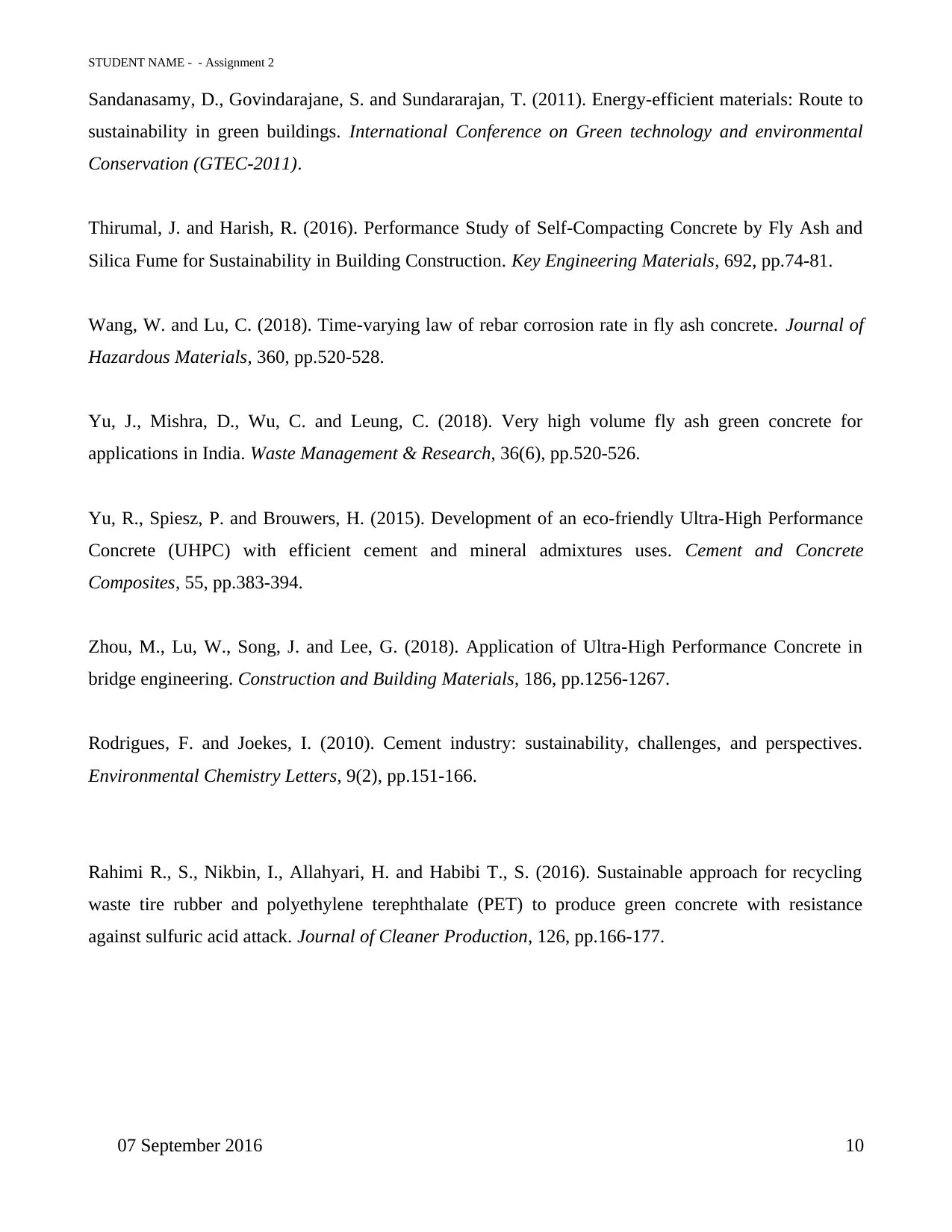
STUDENT NAME - - Assignment 2
Sandanasamy, D., Govindarajane, S. and Sundararajan, T. (2011). Energy-efficient materials: Route to
sustainability in green buildings. International Conference on Green technology and environmental
Conservation (GTEC-2011).
Thirumal, J. and Harish, R. (2016). Performance Study of Self-Compacting Concrete by Fly Ash and
Silica Fume for Sustainability in Building Construction. Key Engineering Materials, 692, pp.74-81.
Wang, W. and Lu, C. (2018). Time-varying law of rebar corrosion rate in fly ash concrete. Journal of
Hazardous Materials, 360, pp.520-528.
Yu, J., Mishra, D., Wu, C. and Leung, C. (2018). Very high volume fly ash green concrete for
applications in India. Waste Management & Research, 36(6), pp.520-526.
Yu, R., Spiesz, P. and Brouwers, H. (2015). Development of an eco-friendly Ultra-High Performance
Concrete (UHPC) with efficient cement and mineral admixtures uses. Cement and Concrete
Composites, 55, pp.383-394.
Zhou, M., Lu, W., Song, J. and Lee, G. (2018). Application of Ultra-High Performance Concrete in
bridge engineering. Construction and Building Materials, 186, pp.1256-1267.
Rodrigues, F. and Joekes, I. (2010). Cement industry: sustainability, challenges, and perspectives.
Environmental Chemistry Letters, 9(2), pp.151-166.
Rahimi R., S., Nikbin, I., Allahyari, H. and Habibi T., S. (2016). Sustainable approach for recycling
waste tire rubber and polyethylene terephthalate (PET) to produce green concrete with resistance
against sulfuric acid attack. Journal of Cleaner Production, 126, pp.166-177.
07 September 2016 10
Sandanasamy, D., Govindarajane, S. and Sundararajan, T. (2011). Energy-efficient materials: Route to
sustainability in green buildings. International Conference on Green technology and environmental
Conservation (GTEC-2011).
Thirumal, J. and Harish, R. (2016). Performance Study of Self-Compacting Concrete by Fly Ash and
Silica Fume for Sustainability in Building Construction. Key Engineering Materials, 692, pp.74-81.
Wang, W. and Lu, C. (2018). Time-varying law of rebar corrosion rate in fly ash concrete. Journal of
Hazardous Materials, 360, pp.520-528.
Yu, J., Mishra, D., Wu, C. and Leung, C. (2018). Very high volume fly ash green concrete for
applications in India. Waste Management & Research, 36(6), pp.520-526.
Yu, R., Spiesz, P. and Brouwers, H. (2015). Development of an eco-friendly Ultra-High Performance
Concrete (UHPC) with efficient cement and mineral admixtures uses. Cement and Concrete
Composites, 55, pp.383-394.
Zhou, M., Lu, W., Song, J. and Lee, G. (2018). Application of Ultra-High Performance Concrete in
bridge engineering. Construction and Building Materials, 186, pp.1256-1267.
Rodrigues, F. and Joekes, I. (2010). Cement industry: sustainability, challenges, and perspectives.
Environmental Chemistry Letters, 9(2), pp.151-166.
Rahimi R., S., Nikbin, I., Allahyari, H. and Habibi T., S. (2016). Sustainable approach for recycling
waste tire rubber and polyethylene terephthalate (PET) to produce green concrete with resistance
against sulfuric acid attack. Journal of Cleaner Production, 126, pp.166-177.
07 September 2016 10
1 out of 10
Related Documents
Your All-in-One AI-Powered Toolkit for Academic Success.
+13062052269
info@desklib.com
Available 24*7 on WhatsApp / Email
![[object Object]](/_next/static/media/star-bottom.7253800d.svg)
Unlock your academic potential
© 2024 | Zucol Services PVT LTD | All rights reserved.





